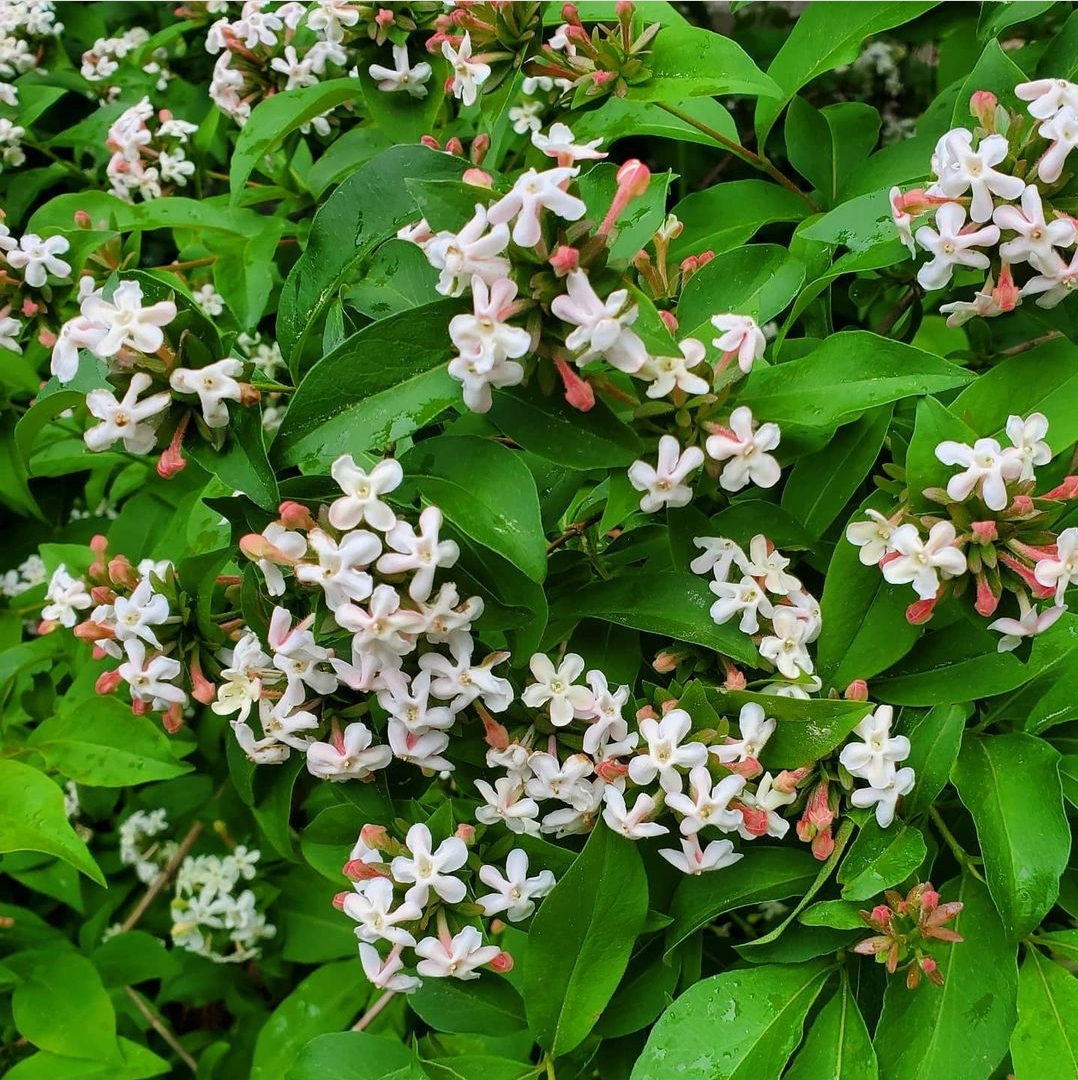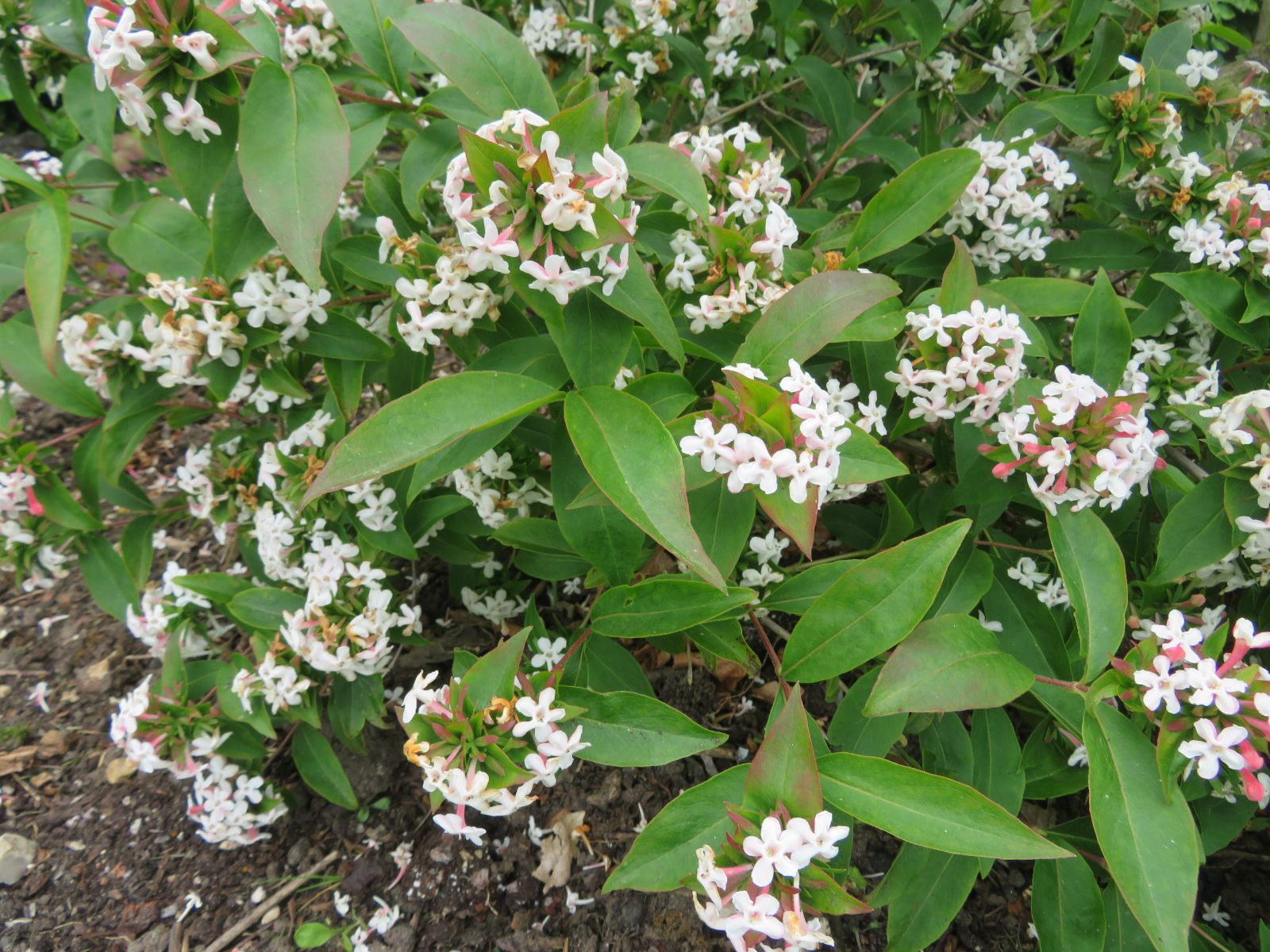Zabelia tyaihyoni
Credits
Owen Johnson (2021)
Recommended citation
Johnson, O. (2021), 'Zabelia tyaihyoni' from the website Trees and Shrubs Online (treesandshrubsonline.
Genus
Common Names
- Korean Abelia
- Fragrant Abelia
- Mangsan Abelia
Synonyms
- Abelia mosanensis T.H. Chung ex Nakai
- Abelia tyaihyoni Nakai
- Abelia tyaihyoni var. mosanensis (T.H. Chung ex Nakai) M. Kim
- Zabelia mosanensis (T.H. Chung ex Nakai) Hisauti & H. Hara
Shrub, rarely to 3 m tall. Shoots green to brown, with stiff recurved hairs, then pale grey; older bark with 6 longitudinal grooves, peeling in between the grooves. Leaf 1.5–6 × 0.6–2 cm, ovate to oblanceolate, tapered at each end, quite glossy above with stiff hairs above the veins, paler beneath with softer hairs; margin ciliate, often entire; autumn colour sometimes red; petiole 1–4 mm long, with curved hairs. Flowers April-June, very fragrant, in a terminal thyrse of congested 3-flowered cymes; peduncle c. 2 cm long, pubescent. Bracts sessile, leaf-like, ovate-acuminate with a cordate base; bracteoles linear to lanceolate. Sepals 5 (rarely 3–4), oblong to linear, pubescent, turning pinkish red. Corolla hairy, white, or reddish-pink outside, with five rounded lobes, 3 larger than the others. Stamens and style inserted, hairless. Fruiting in autumn. (Nakai 1921).
Distribution North Korea Assumed to survive in the east of the country South Korea In the north-east of the country
Habitat Sunny forest ridges, on limestone, 200–300 m asl.
USDA Hardiness Zone 3
RHS Hardiness Rating H7
Awards AGM
Conservation status Endangered (EN)
In contrast to most of the members of this genus, Zabelia tyaihyoni is a fascinating plant in many respects. With its five sepals and five corolla lobes and its richly scented flowers in quite large heads, it is highly distinctive within the Korean flora and its nearest close ally (Z. angustifolia) is found as far away as southern-central China. It has a tiny natural distribution in a politically unstable part of the world; in South Korea, not far from the border zone, it is listed as Endangered and its largest individual population numbers only around a hundred plants (Korean Red List 2021), while its survival in North Korea can only be speculated upon. Its route to cultivation in the west was circuitous, reaching Latvia during the Soviet era (Arboretum Mustila 2021), but over the last two decades it has begun to be recognised as one of the very best plants for a small garden, being floriferous, easy to grow and exceptionally hardy, with a potential role similar to that of Viburnum carlesii and its hybrids. Despite its limited distribution and short time in cultivation, it has managed to acquire a bewildering array of synonyms, variant spellings and sale names.
The species was first described (in Japanese and Latin) as Abelia tyaihyoni by Takenoshin Nakai in 1921 (Nakai 1921); Nakai’s specific name commemorates Tyai-Hyon Chung, the first Korean taxonomist. Chung’s own name for what is generally agreed to be the same plant, Abelia mosanensis, was published five years later; both the combinations in Zabelia were published in 1954. As of 2020, both the Royal Horticultural Society’s database and Plant Finder (Royal Horticultural Society 2020) and The Hillier Manual of Trees and Shrubs (Edwards & Marshall 2019) recommended the name Abelia mosanensis, even though this plant is certainly not an Abelia and both publications accept the generic name Zabelia for the genus’ other species; the precedence of the specific name tyaihyoni over mosanensis also seems clear. The choice of name may have hinged on fears that gardeners in the UK are more accustomed to latinate botanical names than to Korean ones and that ‘tyaihyoni’ might be felt difficult to pronounce or spell; Wikipedia is one resource to have adopted the name Zabelia tyaihyoni but rather proves this point – as of 2021 – by mis-spelling it with a second ‘i’ on the end, inadvertently influencing much online use. The result of such confusion is inevitably to divide the small body of academic botanists, for whom Zabelia tyaihyoni is an Endangered Korean endemic species, from the much wider group of gardeners and plant breeders, for whom Abelia mosanensis is a useful shrub with scented spring flowers, and this taxon presents a particular challenge – or an opportunity – to projects like Trees and Shrubs Online, one of whose raisons d’être is to cultivate common ground between these two communities.
The first western botanists to attempt to introduce Zabelia tyaihyoni may have been the Americans Steven Spongberg and Richard Weaver, who collected seed from the Seoul National University Forest near Gwangyang-si in 1977; this was sown at the Arnold Arboretum in Massachusetts, but did not germinate (Rose 2013). A successful collection was made during an expedition to north-east Korea led by the United States National Arboretum in 1989 (NEKG 150); one scion from this expedition, accessioned in 1998 at the Holden Arboretum in Ohio (98–583), has made a shrub nearly 3 m tall (Royal Botanic Garden Edinburgh 2021). Meanwhile, plants collected in North Korea had been distributed around the Soviet Union, and remained in cultivation in Latvia (Arboretum Mustila 2021); after the Iron Curtain lifted, this cultivated population seems to have been the source for nearly all of the plants now grown and sold in Europe and North America. Tim Wood, employed as a plant scout by the Proven Winners plant brand, obtained material from a Latvian grower he happened to meet in Germany around 1999 (Wood 2006), and the Arnold Arboretum was finally able to add Zabelia tyaihyoni to its collection in 2003 with the purchase of two plants from Tim’s Spring Meadow Nursery (Rose 2013). In the same year, the Arboretum accessioned a third plant grown from seed obtained directly from Latvia, which had been offered in the Index Seminum of the Academy of Science in Salaspils (Rose 2013). A plant was established at the J.C. Raulston Arboretum in North Carolina by 2004 (Dirr 2009), and the Arboretum Mustila in Finland also obtained material directly from Latvia (Arboretum Mustila 2021).
Various sale names have begun to appear as Zabelia tyaihyoni becomes more and more popular. These include ‘Monia’ (Abelia mosanensis BRIDAL BOUQUET®) in Germany (since 1999) and in the UK, ‘Eplida’ (Abelia mosanensis IDA®) in Norway, ‘Korean Spring’ from Hayloft Plants in the UK (this clone received the Royal Horticultural Society’s Award of Garden Merit), and Abelia mosanensis SWEET EMOTION®, Proven Winners’ original sale name in the United States. However, given the species’ circuitous route to cultivation in the west, it seems unlikely that these various names reflect much in the way of genetic diversity, and some of these forms could even turn out to be clonally identical. For a plant which seems the perfect candidate for ex-situ conservation, this lack of diversity might be a source of concern; the Korean Red List (Korean Red List 2021) admits that there are no regional conservation measures to help protect the species’ tiny wild populations, but also suggests that these are threatened by illegal collection – presumably referring to the risk of wild plants being dug up for domestic horticultural use.
Given the range of names under which Zabelia tyaihyoni is already sold in the west, it is inevitable that the true species is sometimes enmired in confusion. At the University of Wroclaw Botanical Garden in Poland it is apparently grown as (Zabelia biflora); conversely, at least one online (photograph) of a ‘Zabelia tyaihyoni’ seems to show Abelia chinensis. Fortunately, the real Zabelia tyaihyoni is a highly distinctive plant and imposters should always be easy to spot.
Zabelia tyaihyoni is a very hardy plant. It is successfully grown in Anchorage, Alaska, and in Helena, Montana (USDA hardiness zone 4a) (Dave’s Garden 2021), while a (Norwegian supplier) suggests it may prove even tougher. (The possibility of misidentification can be dismissed this time: no lookalike plant is likely to survive in such places.) Although Z. tyaihyoni derives from a continental climate, with warm humid summers, it strongly dislikes the prolonged heat of the American Deep South (Dirr 2009), but is more successful in the Mediterranean-type climate of California (Hatch 2021–2022), where flowering extends through May and June. It is sometimes suggested to be calcifuge, but like most Zabelia species it grows in the wild over limestone. Given an early frost, the autumn colour can be orange and red (Dirr 2009), though the plants at the Arnold Arboretum manage a pinky-brown at best (Rose 2013). Through winter the plant is not showy, but some writers comment on the strikingly pale grey of the young twigs.


